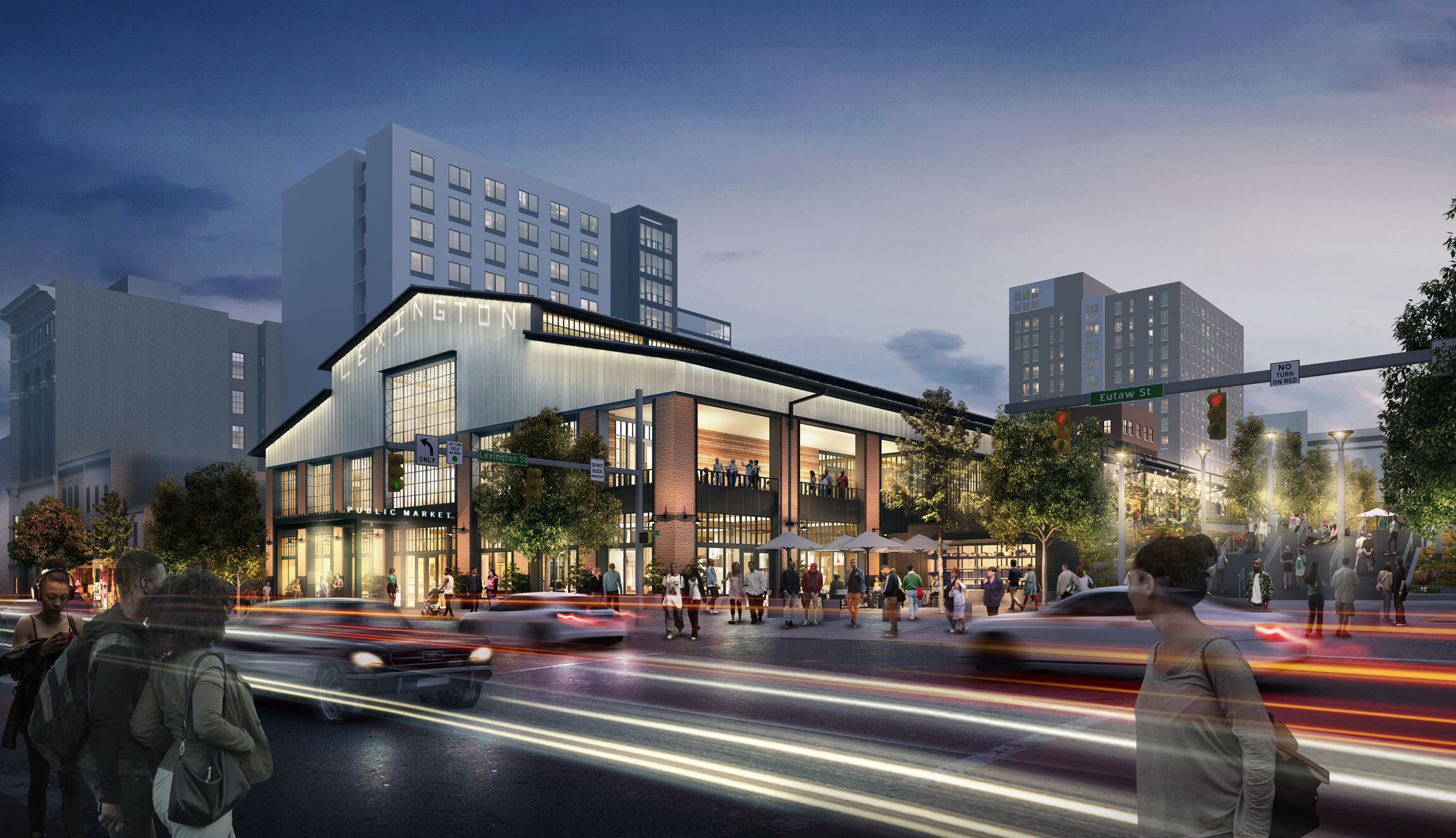Lexington Market

PLANNING / ARCHITECTURE / FOOD EXPERIENCES
Lexington Market
Location
Baltimore, Maryland, USA
Client
Sewall Development
Details
News
Related Work
PROJECT OVERVIEW
With a history dating to 1782, the new Lexington Market is a vibrant public market located in Baltimore, Maryland. Serving as a hub for the surrounding neighborhoods, it offers a diverse array of vendors and cuisines that reflect the city’s rich multicultural heritage. The previous market building needed a major renovation or redevelopment to carry the market forward and serve future generations; a development team was brought on in 2018 to design and build a new, 60,000-square-foot market building and public plaza. The existing market arcade (1980’s) was demolished to make way for a new plaza, and the existing (1950’s) East Market building will be repurposed. The successful redevelopment and thoughtful design of the new market campus ensures Lexington will remain a community fixture for many more generations to come.
COMPLETENESS
The $45 million Lexington Market project was funded and completed through a combination of federal, state, and local support and funds - delivering a financially stable and viable product that will be an asset to the City of Baltimore and entire region for decades to come. The $45 million capital stack consisted of a mix of New Markets Tax Credits, State of Maryland funds, City of Baltimore funds, American Rescue Plan Act (ARPA) funds, and debt equity. The project also built a $1 million low interest, small business loan fund to help local, diverse businesses fund the build out of merchant stalls in the market - funded through a partnership with the University of Maryland-Baltimore and Baltimore Community Lending.
Lexington market will be a catalyst for future west side development
SENSE OF PLACE
For over 200 years, Lexington Market has been a vital cultural and economic hub for Baltimore City and surrounding neighborhoods. To honor its legacy, the new market was designed with a focus on promoting healthy lifestyles, preserving history, and celebrating community diversity. Through community engagement and curated vendor selection, the market reflects the multicultural nature of the area, offering a wide array of cuisines from diverse vendors. It serves as a gathering place for socialization, hosting events and festivals that celebrate the community’s heritage.
The market’s central location and proximity to public transportation make it accessible to the community, addressing the need for convenient shopping and healthy food options. It also provides economic opportunities, fostering growth and supporting local entrepreneurship and small businesses. Feedback from the community is collected and used to adapt offerings, introduce new vendors, and align with evolving needs.
The new market’s design draws inspiration from the historic 1803 market with its large metal roof; and the introduction of clerestory windows allows for an abundance of daylight. The open layout, supported by structural metal trusses, creates unobstructed views, allowing vendors to express their unique offerings. The incorporation of stepped seating and stairs connects different levels, paying homage to the beloved “Baltimore Stoop” where stories are shared among friends.
SUSTAINABILITY
Lexington Market’s sustainability is crucial for its long-term success, encompassing economic, social, and environmental factors.
To achieve economic sustainability, the market focuses on attracting customers and vendors through strategic marketing. Social sustainability is fostered by providing affordable goods, supporting local businesses, and promoting a sense of community. Environmental sustainability is promoted by encouraging eco-friendly practices, utilizing energy-efficient technologies, and implementing waste management systems. The market has also earned LEED Gold Certification.
Adaptability and resilience are vital to respond to changing preferences and needs, while stakeholder engagement ensures collaboration, shared responsibility, and community involvement. Continuous evaluation, improvement, and adaptation are necessary for Lexington Market’s sustainable future.
This transformational project shows the power of the state working together with private partners and the City of Baltimore to better serve Marylanders. - Governor Wes Moore
VISIONARY AND EMULATION
Lexington Market redefines the traditional market concept by offering unique culinary experiences and collaborating with local artists. These initiatives elevate the market’s appeal and create an exciting environment that celebrates local culture. By implementing sustainable practices and engaging the community, Lexington Market sets an example for socially and environmentally responsible marketplaces. Embracing technological advancements further sets it apart, enhancing the customer experience and inspiring others to innovate. Lexington Market’s innovative approaches and emphasis on uniqueness, sustainability, and community engagement make it a benchmark for creating dynamic market experiences.
A NEED
The new Lexington Market was needed by the community for several compelling reasons. Firstly, the previous market had aging infrastructure and facilities that were in dire need of repair and renovation. The physical deterioration of the old market compromised its ability to provide a safe and pleasant shopping experience, and it fell short of meeting modern standards.
Secondly, the community desired a market that better aligned with their changing needs and aspirations. The previous market had limited amenities and services, and it failed to offer a wide range of food options that catered to the diverse tastes of the community. There was a growing demand for healthier and more diverse food choices, and the redevelopment presented an opportunity to address these demands and create a market that better reflected the community’s preferences.
Lastly, revitalizing Lexington Market was seen as a catalyst for economic development in the surrounding area. The new market had the potential to attract more vendors, create job opportunities, and stimulate the local economy. By providing a vibrant and thriving marketplace, the community envisioned a space that would drive foot traffic, support local businesses, and contribute to the overall economic vitality of the neighborhood.
In summary, the new Lexington Market was needed to address the physical deterioration of the old market, meet the evolving needs of the community, and provide a platform for economic growth and development. The redevelopment aimed to create a modern, safe, and inclusive market that would enhance the overall well-being and vibrancy of the community.
Lexington Market 2.0 will build upon what made the old market so special and an unparalleled sense of Baltimore community. - Mayor Brandon Scott






